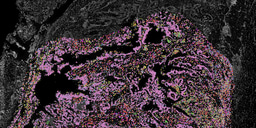The biogeochemical uncoupling of permeable sediments
Published in Microbiology

Instead his work showed that rapid water flow through these permeable sediments meant that solutes did not have time to accumulate or become depleted. Along with his former PhD student Elimar Precht, he captured the amazing dynamics of oxygen in sediment (1), see also Figure 1 below.
How do micro-organisms metabolically adjust to this dynamic oxygen environment?
The immediate assumption based on the paradigms of biogeochemistry is that once oxygen is depleted, microbes will switch to other electron acceptors such as iron, manganese, nitrate and sulphate in order of their free energy yield. My suspicion that this was not the case arose over a decade ago, when I was playing with biogeochemical models set up with the classical redox cascade. They always produced too much denitrification and sulphate reduction, and in the case of denitrification we had to introduce a fudge factor to make the models work, much to the disgust of my collaborator Filip Meysman (2,3). More recently, we showed that under anoxic conditions, metabolism continues in sand but we could not measure any significant rates of denitrification, sulphate or iron reduction. Curiously, we observed high rates of hydrogen production leading us to speculate that fermentation was taking place (4). We started looking for hydrogen in-situ within sand and the overlying water and found concentrations orders of magnitude higher than previously reported. Fortuitously, I was on sabbatical in Utrecht and was introduced to Elena Popa, who has undertaking state-of-the-art isotope measurements on hydrogen. Her measurements were able to show unambiguously the hydrogen was coming from a biological source. Metaganomics confirmed the abundance of hydrogenases in the sediment and of key importance showed they were consistent with hydrogen production by aerobic facultatively fermentative bacteria. Further incubations confirmed sulphate reduction did not commence for about a week after anoxia and this coincided with a shift in the bacterial community towards a greater abundance of sulphate reducers.
Figure 1. Shows the dynamics of oxygen within rippled permeable sediment in a flume tank with changing flow velocities and direction simulating the rising and falling tide (6 hour timescale). Red denotes high oxygen, black no oxygen. Our work sheds new light on how microbes cope with this dynamic redox environment.
The key point here is that sand sediments are inhabited by aerobic bacteria which are facultatively anaerobic, and carry out fermentation under anoxic conditions. It is only after prolonged anoxia (days-weeks) that a new sulfate reducing community develops and dominates metabolism. This has important consequences for how we set up biogeochemical models of permeable sediments and raises the question as to what type of fermentation pathways are taking place in these sediments during short term anoxia.
References
1. Precht, E., Franke, U., Polerecky, L. & Huettel, M. Oxygen dynamics in permeable sediments with wave-driven porewater exchange. Limnol. Oceanogr. 49, 693-705 (2004).
2. Cook, P. et al. Quantification of denitrification in permeable sediments: Insights from a two-dimensional simulation analysis and experimental data. Limnology and Oceanography: Methods 4, 294-307 (2006).
3. Kessler, A. J. et al. Quantifying denitrification in rippled permeable sands through combined flume experiments and modelling. Limnol. Oceanogr. 57, 1217-1232 (2012).
4. Bourke, M. F. et al. Metabolism in anoxic permeable sediments is dominated by eukaryotic dark fermentation. Nat. Geosci. 10, 30-35, doi:10.1038/NGEO2843 (2017).
Follow the Topic
-
Nature Microbiology

An online-only monthly journal interested in all aspects of microorganisms, be it their evolution, physiology and cell biology; their interactions with each other, with a host or with an environment; or their societal significance.
Related Collections
With Collections, you can get published faster and increase your visibility.
Progress towards the Sustainable Development Goals
Publishing Model: Hybrid
Deadline: Ongoing
The Clinical Microbiome
Publishing Model: Hybrid
Deadline: Dec 11, 2025





Please sign in or register for FREE
If you are a registered user on Research Communities by Springer Nature, please sign in